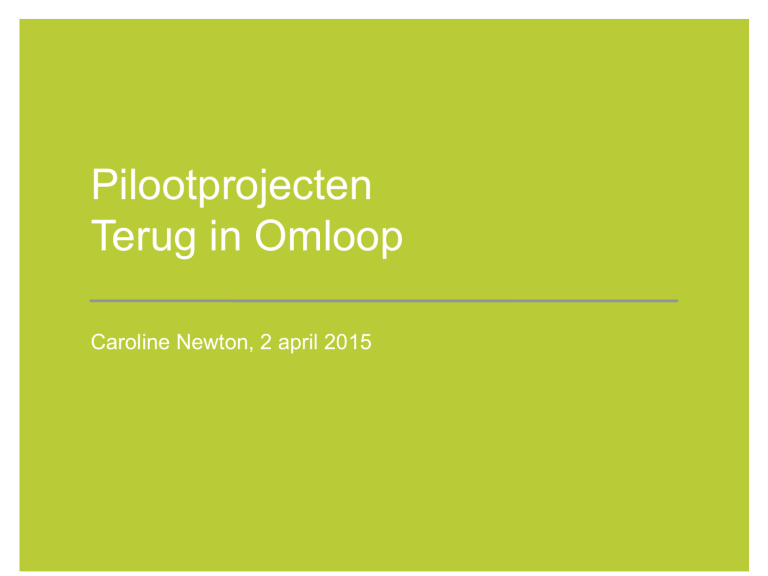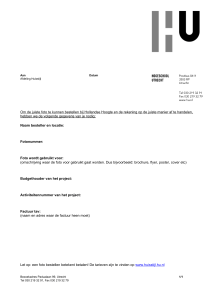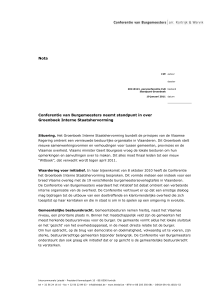
Pilootprojecten
Terug in Omloop
Caroline Newton, 2 april 2015
Context
Klimaatverandering
Demografie
Crisis en schaarste (zie oa. www.SCIBE.eu)
à Maar ook creativiteit en nieuwe economische
modellen
Productie – collaborative – peer-to-peer – commons – sharing – nanotechnologie – stad als metabolisme – materiaalstromen – growfunding
– crowdfunding – geïntegreerde ontwikkeling – creative industry - ……
Ruimtebeslag
Europese Commissie (2011) à bijkomend ruimtebeslag
tegen 2050 afbouwen tot 0
Ruimtebeslag?
- Groenboek Beleidsplan Ruimte
- duidt op dat deel van de ruimte waarin de
biofysische functie niet langer de belangrijkste is.
- Het gaat, met andere woorden, om de ruimte
ingenomen door wonen, werken, recreëren en
mobiliteit.
Spreker
3 april 2012
Ruimtebeslag in Vlaanderen
Bron: VITO (2014) Eindrapport Verklarende factoren in de evolutie vna het Ruimtebeslag
Ruimtebeslag in Europa
Land cover 2006 (% of total)
Artificial surfaces 2006 (% of total area)
2% 3%
Vlaanderen: +/- 20%
4%
3%
6%
8%
25 %
4%
13 %
17 %
35 %
80 %
Artificial areas
Housing, services, recreation
Arable land and permanent crops
Industrial, commercial units, construction
Pastures and mosaics
Transport networks, infrastructures
Forested land
Mines, quaries, waste dumpsites
Semi-natural vegetation
Open spaces/bare soils
Wetlands
Water bodies
Bon: Share of land-cover types in Europe: total area (left); artificial surfaces
(right)(results for 36 countries in Corine land cover 2006 data set) (http://
www.eea.europa.eu)
Ruimtebeslag in Europa
Artificial surfaces 2006 (% of total area)
Land cover 2006 (% of total)
2% 3%
4%
3%
6%
8%
25 %
4%
13 %
17 %
35 %
80 %
Artificial areas
Housing, services, recreation
Arable land and permanent crops
Industrial, commercial units, construction
Pastures and mosaics
Transport networks, infrastructures
Forested land
Mines, quaries, waste dumpsites
Semi-natural vegetation
Open spaces/bare soils
Wetlands
Water bodies
Bon: Share of land-cover types in Europe: total area (left); artificial surfaces
(right)(results for 36 countries in Corine land cover 2006 data set) (http://
www.eea.europa.eu)
Artificial surfaces 2006 (% of total area)
3%
4%
13 %
80 %
Housing, services, recreation
Industrial, commercial units, construction
Transport networks, infrastructures
Mines, quaries, waste dumpsites
Vlaanderen:
Ø 68% voor wonen
Ø Groei ruimtebeslag vooral aan wonen te wijten
Ø 1985-2013 dagelijkse aangroei in ha/dag:
Ø Wonen: 6,2
Ø Anderen: 2,8
Bron: VITO (2014) Eindrapport Verklarende factoren in de
evolutie vna het Ruimtebeslag
Ruimtebeslag in Europa
Land cover 2006 (% of total)
Artificial surfaces 2006 (% of total area)
2% 3%
Vlaanderen: +/- 20%
4%
3%
6%
8%
25 %
17 %
35 %
4%
13 %
Ook in het groenboek is er de
ambitie om het ruimtebeslag
niet meer te laten toenemen
(p.21)
RUIMTENEUTRALITEIT
80 %
Artificial areas
Housing, services, recreation
Arable land and permanent crops
Industrial, commercial units, construction
Pastures and mosaics
Transport networks, infrastructures
Forested land
Mines, quaries, waste dumpsites
Semi-natural vegetation
Open spaces/bare soils
Wetlands
Water bodies
Bon: Share of land-cover types in Europe: total area (left); artificial surfaces
(right)(results for 36 countries in Corine land cover 2006 data set) (http://
www.eea.europa.eu)
Hergebruik en ruimtelijke beleid
Bron: TRITEL & AMRP, departement RWO, Brussel
© department RWO
Ruimteneutraliteit
(groenboek, 2012)
Ruimteneutraliteit
MVRDV, expo 200 (Hanover)
(groenboek, 2012)
Ladder van Lansink
Reduce
Ruimteneutraliteit
MVRDV, expo 2000 (Hanover)
(groenboek, 2012)
Ladder van Lansink
Reduce
Reuse
Bogdan & Van Broeck, MAD Faculty, C-Mine
Foto: Thomas Mayer
Reduce
Reuse
Recycle
De Ceuvel, Amsterdam
Foto: www.leonieproeft.nl
Stedelijkheid
Sanering
Nieuwe Economie
Spreker
3 april 2012
Meer info:
[email protected]
http://vlaamsbouwmeester.be











